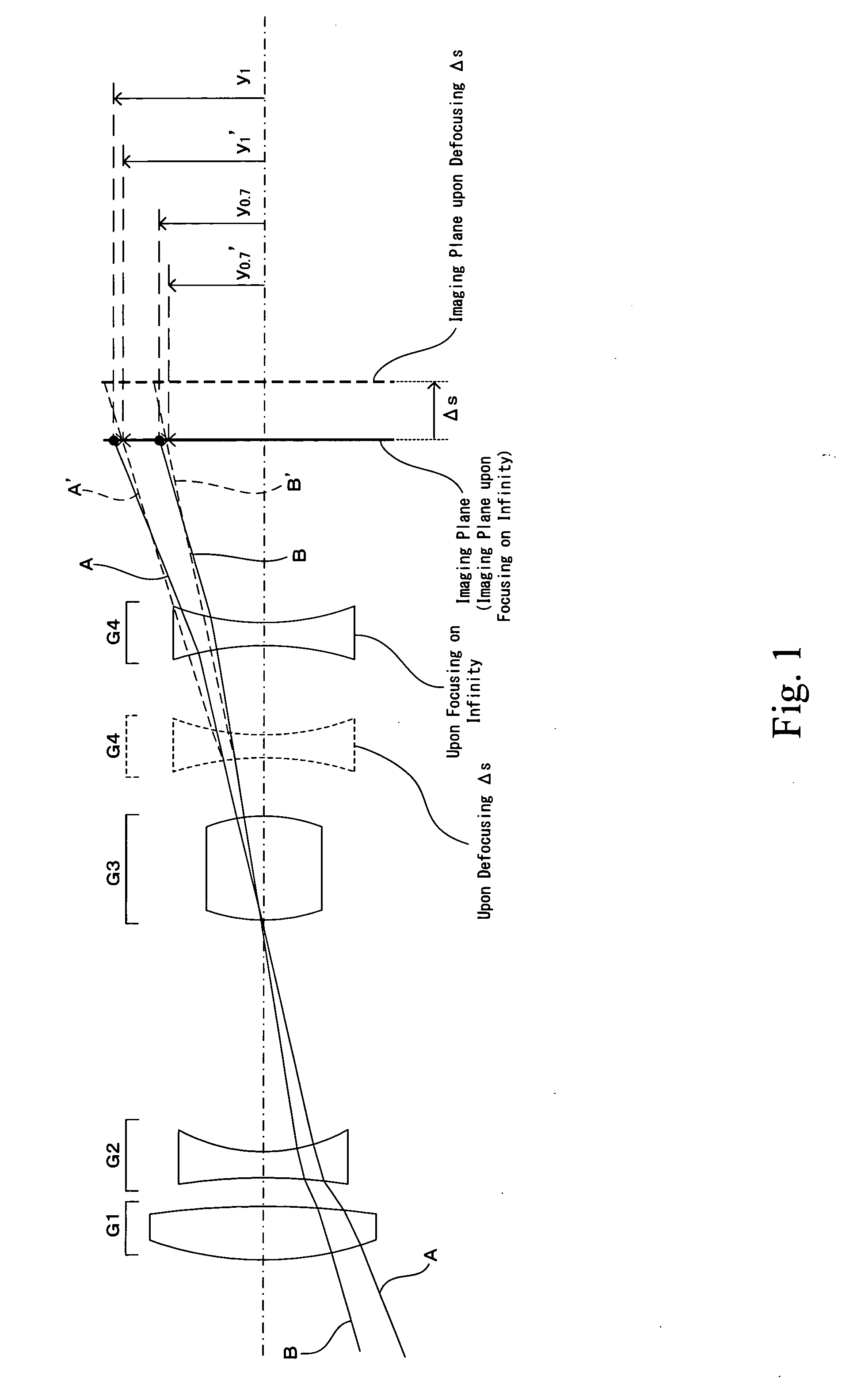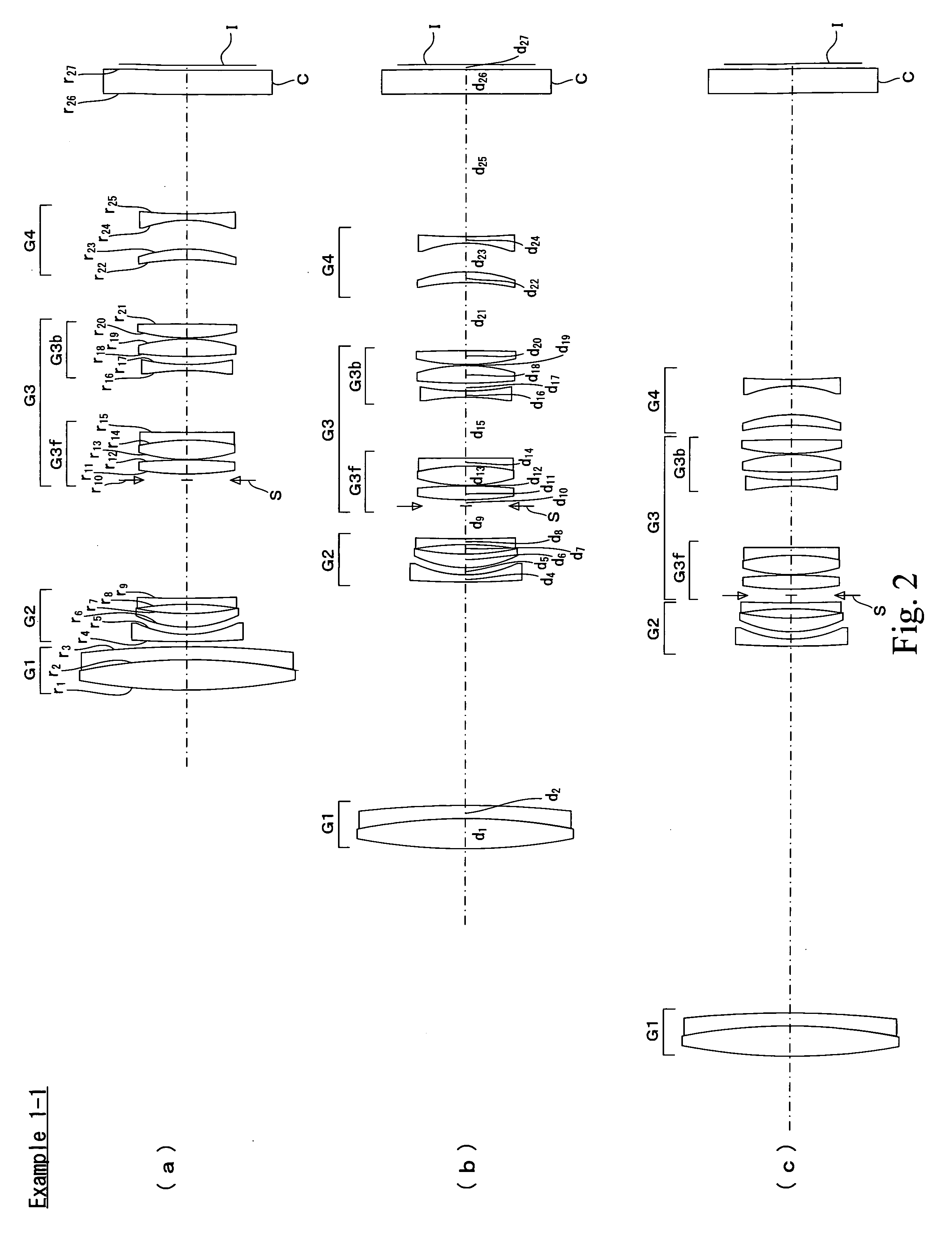Zoom lens, and imaging apparatus incorporating the same
- Summary
- Abstract
- Description
- Claims
- Application Information
AI Technical Summary
Benefits of technology
Problems solved by technology
Method used
Image
Examples
example 1-1
[0249]FIG. 2 is a sectional view of the zoom lens of Example 1-1. As shown in FIG. 2, the zoom lens of Example 1-1 is built up of, in order from the object side to the image side, a first lens group G1 of positive refracting power, a second lens group G2 of negative refracting power, a third lens group G3 of positive refracting power, and a fourth lens group G4 of negative refracting power. In FIG. 2, I and C are indicative of an image plane and a cover glass, respectively.
[0250]The first lens group G1 is made up of a cemented lens of a positive lens and a negative lens.
[0251]The second lens group G2 is made up of, in order from the object side to the image side, a negative lens, a positive lens and a negative lens.
[0252]The third lens group G3 is made up of, in order from the object side to the image side, a stop S, a front unit G3f consisting of a positive lens and a cemented lens of a positive lens and a negative lens, and a rear unit G3b consisting of a negative lens, a positive...
example 1-2
[0259]FIG. 3 is a sectional view of the zoom lens of Examples 1-2. As shown in FIG. 3, the zoom lens of Example 1-2 is built up of, in order from the object side to the image side, a first lens group G1 of positive refracting power, a second lens group G2 of negative refracting power, a third lens group G3 of positive refracting power, and a fourth lens group G4 of negative refracting power. In FIG. 3, I and C are indicative of an image plane and a cover glass, respectively.
[0260]The first lens group G1 is made up of a cemented lens of a positive lens and a negative meniscus lens.
[0261]The second lens group G2 is made up of, in order from the object side to the image side, a cemented lens of a negative lens and a positive lens, and a negative lens.
[0262]The third lens group G3 is made up of, in order from the object side to the image side, a stop S, a front unit G3f consisting of a positive lens and a cemented lens of a positive lens and a negative lens, and a rear unit G3b consisti...
##meral example 1-1
Numeral Example 1-1
[0272]
Surface No.rdndνd 187.8055.0001.5163364.14 2−87.8052.1001.7847225.68 3−178.563 d3 (Variable) 4107.0591.1301.7291654.68 518.7231.247 619.7542.2051.8466623.78 740.8301.481 8−47.2391.0201.7880047.37 9340.768 d9 (Variable)10 (Stop)∞0.9001136.6692.2761.4970081.5412−101.1340.1501326.3523.1701.4874970.2314−39.1311.2001.9108235.2515401.57010.124 16−40.8840.9501.8340037.161733.7931.2771863.4062.9731.6031160.6419−25.0580.1502035.6942.2901.7725049.6021−128.815d21 (Variable)22−37.4151.7001.5927035.3123−22.3814.70024−19.3901.0001.6031160.642586.781d25 (Variable)26∞4.0001.5163364.1427∞0.800Image Plane∞Data Set 1WESTTEFocal length40.80477.526147.015Fno4.084.455.872ω (°)30.4115.698.30Image Height10.8210.8210.82BF22.81926.66749.994d30.80036.33660.036d919.2515.3001.022d2110.47310.9572.294d2519.38023.22846.555Data Set 2f1139.30f2−35.21f329.05f4−38.89
PUM
 Login to View More
Login to View More Abstract
Description
Claims
Application Information
 Login to View More
Login to View More - Generate Ideas
- Intellectual Property
- Life Sciences
- Materials
- Tech Scout
- Unparalleled Data Quality
- Higher Quality Content
- 60% Fewer Hallucinations
Browse by: Latest US Patents, China's latest patents, Technical Efficacy Thesaurus, Application Domain, Technology Topic, Popular Technical Reports.
© 2025 PatSnap. All rights reserved.Legal|Privacy policy|Modern Slavery Act Transparency Statement|Sitemap|About US| Contact US: help@patsnap.com



